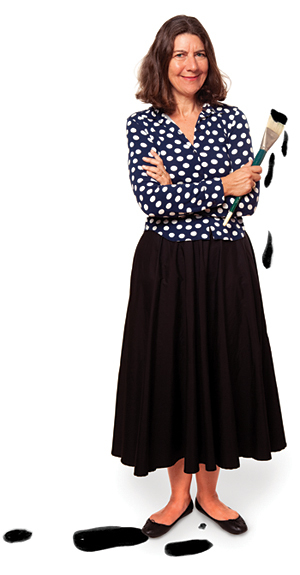Absolutely Dino-mite!: Jessie Hartland’s latest picture book puts a new spin on kids’ favorite reptiles | Under Cover

How the Dinosaur Got to the Museum tells the true story of how a 145-million-year-old Diplodocus longus ended up at the Smithsonian in Washington, DC. Were you crazy about dinosaurs as a kid?
I was not one of those kids who were especially excited about dinosaurs. I didn’t really know much about them, and I didn’t think there were dinosaurs in the United States. I thought they were in Africa or India—in some exotic place. So I was delighted to learn that they were in this country and people are still finding bones all over the place—even in New York State.

Photo by Matt Peyton/Getty Images for SLJ.
Artwork courtesy of Jessie Hartland.
As part of your research, Michael Brett-Surman, the Smithsonian’s dinosaur expert, invited you on an archaeological dig in Wyoming. How cool was that?
We went to a dig where they’re actually digging up the same kind of dinosaur, Diplodocus longus, and I got to take pictures and talk to the people working on the dig. It was very interesting. I knew that the Diplodocus longus in my book died in a flood. There were a number of dinosaurs that were swept off their feet by this river and ended up in a pile. Millions of years went by and sand and silt built up and now it’s no longer a river—it’s just an old riverbed, and I got to see it. You can see the terrain, all the lines in the landscape, the different layers, the millions of years.
Did you get to touch some bones?
Yes. Of course, I’d never actually seen dinosaur bones, except in a museum. And here there were people digging them up, and we could pick them up. Some of the pieces are so small that they look like rocks. The paleontologist told us that dinosaur bones are very porous. So if you’re not sure whether it’s a stone or a bone, you can put it on your tongue. If it sticks to your tongue, you know that it’s a bone.
The colors in your new book are gorgeous. Somehow it’s fitting that the very first kids’ book you ever illustrated was about Henri Matisse, the greatest colorist of them all.
I just love thinking about color. Sometimes I’ll lie in bed at night, and I’ll just get these flashes of color and think about this color next to that color. I just think about it all the time. I drive into the city from my house on Long Island on Sunday evenings, and I time the drives so that I’m driving into the sunset and I can watch the colors.
What’s your favorite?
I especially adore turquoise—it’s the color of a warm sea and I love to swim.
Illustrators often sneak personal references into their books. Are there any in yours?
Well, the young boy who asks the question at the beginning of the book—“So how did the dinosaur actually get to the museum?”—looks like my son, Sam, who’s now about to turn 20.
You’re a successful painter, commercial artist, and children’s book creator. But what are kids most curious about when you visit their schools?
They ask me what kind of student I was, and I’ve explained how [when I was growing up in Washington, DC] I wasn’t a great student; I was a daydreamer. I was completely in my own world, literally making up another world while the real one was going on. And then—it’s very funny—I was visiting a school on the Upper West Side, and the very next question that somebody asked was, how do you get your ideas? And, of course, I had to say, “That’s where daydreaming comes in handy!”
RELATED
The job outlook in 2030: Librarians will be in demand
The job outlook in 2030: Librarians will be in demand
ALREADY A SUBSCRIBER? LOG IN
We are currently offering this content for free. Sign up now to activate your personal profile, where you can save articles for future viewing






Add Comment :-
Be the first reader to comment.
Comment Policy:
Comment should not be empty !!!